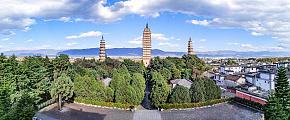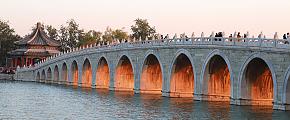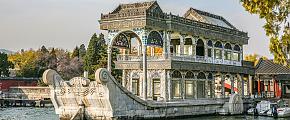Glazed Tile, Stone Baluster Head, Stone Lions, Door Stud in the Forbidden City of Beijing
Glazed Tile
The glazed tile, as a high-grade building material in old China, was used exclusively on palace buildings of the imperial house of the big mansions of nobles and high officials.
The glaze was normally in one of four colors: yellow, green, blue, and black. Tiles coated with it not only add splendor to the buildings but, in old times, carried a political significance.
Yellow tiles were reserved for use on the roofs of royal palaces, mausoleums, imperial gardens, and temples. This, it is said, was because yellow is the color of the Yellow River, once believed to be the cradle of the Chinese civilization, probably for the same reason the earliest leader of the alliance of the tribes in prehistoric legend was named Huangdi or the Yellow Emperor, whose descendants all Chinese are supposed to be. In the meantime, the ancients believed that the physical universe was composed of five elements - metal, wood, water, fire, and earth, and the yellow color represented earth, which lay at the center of the universe. Yellow, therefore, was taken as the cardinal color of the core and became the royal color to be used exclusively by the rulers.
 Forbidden City
Forbidden City
It can be seen that the colors of the roof tiles indicated the positions of the people who lived in the house. Even in the same part, for instance, in the Summer Palace of Beijing, differently colored tiles were used for different houses. The groups of halls and pavilions used by the monarch and his family, visitors will notice, have yellow roofs whereas the quarters for the court officials have green roofs. As for other structures erected for landscaping or for the accommodation of people without a senior rank, they have, as a rule, black tiles.
Tiles of yellow glaze, however, also cover certain halls that were not built for the imperial family, for instance, temples dedicated to Confucius and Guan Yu, worshipped for his bravery and loyalty, but this was because they were canonized by emperors of later dynasties as their equals and given posthumous titles as such.
Colors on ancient buildings were not only status indicators but, in certain cases, carried other implications. One example is Wenyuange, the imperial library in Beijing's Forbidden City, which, amidst many yellow roofs, stands under a roof of black tiles.
The reason: books were liable to catch fire, black was supposed to be the color of water, and a black-colored roof would mean ever-ready water to put out fires.
Another example is the buildings of the Temple of Heaven. They were roofed with blue tiles for the evident reason that blue is the color of Heaven.
Incidentally, mention should be made of the red enclosure walls that invariably go with the yellow roofs of imperial palaces. Red has always been the color of happiness and festivity in China; even today, red lanterns and red streamers are still dominant features on occasions of public enjoyment. Red walls, however, could only be built for palaces and temples, and, in combination with the yellow glazed roofs, they were meant to play up the atmosphere of solemnity and happiness.
Stone Baluster Head
Important halls, towers, and pavilions in the old palaces of China normally stand on terraces. There are bordered by marble balustrades; so are many historic bridges of stone. The upright posts or balusters supporting them, called Wangzhu in Chinese, have heads sculpted in the shapes of dragons, phoenixes, lions, flames, and so on. They are not only highly ornamental but serve to reflect hierarchical ranks.
Dragon-and-phoenix images on baluster heads were exclusive to imperial buildings. These legendary creatures, carved with clouds, are often placed on top of the stone posts around audience halls, palace gates, and halls of worship. They are, however, found in the greatest concentration around the group of buildings known as San Da Dian (The Three Great Halls) in Beijing's Forbidden City. These halls stand majestic on a terrace of three tiers, each of which is surrounded by a white marble balustrade. The 1,460 balusters, viewed from a distance, look like a "Stone Forest" and give the halls an ethereal loftiness.
This arrangement is unique to "The Three Great Halls" as the site where the emperor held grand ceremonies, received his ministers, and issued important edicts. For people of a lesser rank to use, this magnificent layout or the dragon-and-phoenix motif would be a crime punishable as high treason.
The differentiation of status is most noticeable on the five bridges spanning the Golden Water River just inside Wumen, the Meridian Gate of the Forbidden City. The middle bridge, i.e., the one used by the emperor, has balusters topped with carved dragons and clouds, whereas the other four have on the baluster crowns designs of flames as ornaments and symbols of illumination. For the lesser buildings on the palace grounds, the decorations for stone baluster heads are generally Ruyi, pomegranates, lions, and others, which signify good luck, happiness, and longevity.
At the eastern end of the Golden Water River, there is a baluster whose head could be used as a siren. Carved in the Qing Dynasty( 1616-1911)in the form of fire flames over a lotus blossom, the post has an opening running from the top to a string of beads under the flower. In case of an emergency, the guard could blow into the top hole, and the baluster head would sound warning alarms like a horn.
Stone Lions
In front of the gates of traditional buildings-palace halls, old government offices, mansions, and other houses of style can still see a pair of lions standing guard. Carved out of stone, they are a male and a female, with the male on the left, his right paw resting on a ball, and the lioness on the right, her left paw fondling a cub.
The lion was thought to be the monarch of the animal kingdom, and its images represented august power and formidable prestige to keep all quarters in awful submission. The ball played by the male lion symbolized the unity of the empire and the cub below the female thriving offspring.
 Stone Lion in Forbidden City
Stone Lion in Forbidden City
The use of the lions was not the exclusive privilege of the court. Other personages of rank could also have them in front of the main entrances to their houses, with their ranks indicated by the number of lumps representing the curly hair on the head of the animal. Lions with 13 lumps, the highest number, guarded the houses of officials of the first grade, and the number of these lumps decreased by one as the rank of the official went down each grade. Officials below the seventh grade, however, were not allowed to have stone lions.
At the dawn of history, China had no lions, whose habitat was Africa and West Asia. Official contacts with countries to the west were established after Zhang Qian (?-114 B.C.) was despatched to Central Asia as a special envoy by Emperor Wu of the Han Dynasty. In A.D.87, when Emperor Zhang of the Eastern Han reigned in China, the King of Parthia presented a lion to him; the next year, another was presented to the Chinese court by a Central Asian country known as Yuezhi ancient China.
The existence of stone lions may have preceded that of real ones. It is believed that the earliest stone lions were sculpted at the beginning of the Eastern Han Dynasty (25-220 A.D.) with the introduction of Buddhism into China. Sakyamuni (founder of the faith), it is said, was seen after his birth "to point to Heaven with one hand and to Earth with another, roaring like a lion, `Between Heaven and Earth I alone am supreme. " Elsewhere, it is also said that "Buddha is a lion among men." "Buddhists admiring the lion for its mighty swiftness made it the mount for the Bodhisattva Manjusri." In short, the lion is regarded in the Buddhist faith as a divine animal of nobleness and dignity, able to keep off evils and protect the Truth.
For the same reason, it was a custom to use figures of the lion to decorate certain structures, especially stone bridges. A prominent example is the Lugouqiao or Marco Polo Bridge near Beijing. Adorning the heads of its stone balusters are 501 lions of varying sizes and postures.
As further proof of the general liking for the animal, the knobs of seals are often sculpted in the form of lions. Among folk dances, the lion dance, which was known as early as the Han Dynasty, has remained popular ever since.
Door Studs
The main entrances to ancient palaces, temples, and mansions have doors with studs arranged in rows. Like other decorations on traditional buildings, the studs served to indicate ranks in the feudal hierarchy.
Door studs go back a long time in history. To keep off aggression, heavy city gates were built and braced on the surface with iron plates, which were fastened or by means of studs. This system lasted for thousands of years.
 Door with Studs Arranged in Rows in Forbidden City
Door with Studs Arranged in Rows in Forbidden City
The door studs on the gates of the Forbidden City were made of brass and plated with gold. Lustrous, they add to the splendor and magnificence of the imperial palace. All the gates used by the emperor have 9 X 9 or 81 studs, as the number nine represents the supremacy of the monarch. Other titled personages, princes, and barons had fewer studs on their gates, such as nine rows seven each, 7 x 7, or 5 5; those who had lower ranks had studs made of iron.
An interesting question arises with regard to the Donghuamen gate of the Forbidden City, which, unlike the other principal entrances, has 72 studs instead of the usual 81. The explanation lies in a historic event. At the end of the Ming Dynasty, the capital fell to Li Zicheng, leader of a famous peasant revolt in 1644. It was by Donghuamen that Chongzhen, the last Ming emperor, left the palace and then hanged himself at Jingshan (Hill of Prospect, popularly known as Coal Hill). The Qing house, which replaced the Ming, regarded Donghuamen as inauspicious and decided to use it for the exit of imperial hearses and cut down the number of its studs at the same time.
Knocker Base
The two-leafed gate of a traditional Chinese house has a pair of ring knockers, whose base, called pushes, also serves a decorative purpose.
The knocker bases for a private house are fixed only on the outermost, more solidly built gate. They are normally simple discs made of iron or brass. People who call at the house will tap one of the rings lightly, which will hit the base to produce clear percussions. In answer to the sound, the people of the house will come to open the door to greet the visitor. When the owner of the house goes out, he can lock up the gate by fastening the knocker rings together.
The knocker bases on palace gates, naturally, are much more elaborate. Made of gold-gilded brass, they are in the form of tigers, lions, turtles, snakes, or other animals that were supposed to possess magic powers or unequaled strength. The consummate art with which they were carved also contributed to the splendor of the edifices.
Pushou first appeared in China during the Han Dynasty (206 B.C.-220 A.D.) and has a history of 2,000 years. Today, they still decorate the houses newly built in the countryside, but they are disappearing in cities where modern multi-storeyed buildings are being constructed in increasing numbers.
 Knocker Base
Knocker Base
Water Vat
In the courtyards of palaces and imperial gardens, water vats are seen standing not far from the main buildings. In their time they were filled with water against the emergency of fire. In winter, they were covered and wrapped around with quilts and, when necessary, heated from below with charcoal to prevent the water from freezing. There were, in the old days, 308 such vats in the Forbidden City of Beijing; now, only a little over 200 are counted.
The water vats were not only fire-fighting installations but also part of the adornments that made up imperial magnificence. In the Ming Dynasty (1368-1644), they were mostly made of iron or bronze, but they became much more elaborate and finely made in the Qing (1644-1911), being of gold-plated brass and adorned with rings and side knobs in the form of animal heads.
These water vats fall into different grades. Flanking the front of such important halls as Taihedian (Hall of Supreme Harmony), Baohedian (Hall of Preserving Harmony), and Qianqingmen (Gate of Heavenly Purity) are huge vats, each weighing 3,392 kilograms and measuring 1.6 meters in diameter. Near less important buildings, the vat weighs 2,166 kilograms and measures 1.28 meters. Still less important pavilions and towers have iron or bronze vats of yet smaller sizes.
Visitors to the old imperial palace today can no longer see the gold-plated brass vats as they were in their time. This is because the gold plate was scraped off with bayonets by troops of the Eight-Power Allied Forces, which invaded China in 1900.
Zoomorphic Ornaments
Chinese palaces, temples, and mansions have on their roofs a special kind of ornaments called Wenshou or zoomorphic ornaments, some on the main ridges and some on the sloping and branch ridges.
The monstrous thing at either end of the main ridge, called Chiwen, appears roughly like the tail of a fish. Fierce and formidable, it looks as if it were ready to devour the whole ridge, so it is also known as tundish or the ridge-devouring beast. It is, according to Chinese mythology, one of the sons of the Dragon King who rules the seas. It is said to be able to stir up waves and change them into rain. So, the ancient Chinese put a chin at either end of the main ridge for its magic powers to conjure up a downpour to put out any fire that might break out. But for fear that it might gobble up the ridge, they transfixed it on the roof with a sword.
At the end of the sloping and branch ridges, there is often a string of smaller animals, their sizes and numbers being decided by the status of the owner of the building in the feudal hierarchy.
 Zoomorphic Ornaments
Zoomorphic Ornaments
The largest number of zoomorphic ornaments is found in the Taihedian Throne Hall or the Hall of Supreme Harmony of the Forbidden City. Leading the flock is a god riding a phoenix, after whom come a dragon, a phoenix, a lion, a heavenly horse, a sea horse, and five other mythological animals, all called by unusual names. Quanqinggong (the Palace of Heavenly Purity), which the emperor used as his living quarters and his office for handling daily affairs, being next in status to Taihedian, has a band of nine animal figures. Still next in importance is Kunninggong (the Palace of Female Tranquility), which served as the empress's apartments; it has a group of seven zoomorphic figures. This number is further reduced to five for the twelve halls in side courtyards, that used to house the imperial concubines of different grades. Some of the side halls have only one animal figure on their roofs.
These small animals were also believed to be capable of putting out fires. While this can be easily dismissed as superstition, they do add to the grandeur and magnificence of the imperial buildings.
The earliest ridge animals so far discovered in the country came to light in 1960 in a suburban area of Shashi, Hubei Province. On the interior wall of a roll tile, which served as the body of a ridge animal figure, was engraved "first year of Yuanguang," which means the year 134 B.C. It can be seen that installing animal figures on roof ridges has been an established practice for at least 2,100 years.
Quick Question
Related Posts You May Like
What Our Clients Say
"Great Customized Service", "Trip of A Lifetime", "Exceed All Expectations"
SUBSCRIBE TO WIN A FREE TOUR
Subscribe to our newsletter for a chance to win a free 7-day South Korea tour! And more insider travel news, exclusive offers, and inspiration will be sent straight to your inbox.







